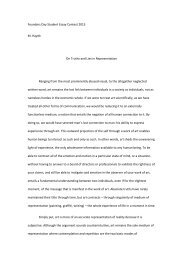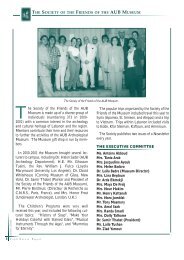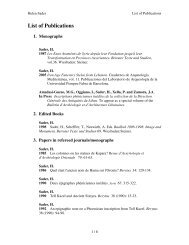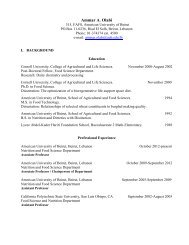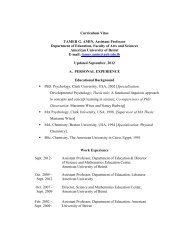The IX t h Makassed Medical Congress - American University of Beirut
The IX t h Makassed Medical Congress - American University of Beirut
The IX t h Makassed Medical Congress - American University of Beirut
Create successful ePaper yourself
Turn your PDF publications into a flip-book with our unique Google optimized e-Paper software.
T h e I X t h M a k a s e d M e d i c a l C o n g r e s s<br />
OESOPHAGEAL ATRESIA: RECENT ADVANCES AND LONG TERM OUTCOME<br />
Frederic Gottrand MD, PhD<br />
Oesophageal atresia is a rare malformation with an incidence <strong>of</strong> 1/3000. Recent advances in<br />
surgery and neonatal care have provided a better prognosis, the survival rate <strong>of</strong> infants born with<br />
oesophageal atresia has dramatically improved over the last decade increasing from 80% to<br />
more than 95%. However oesophageal atresia is definitively not only a neonatal surgical issue but<br />
a long lasting disease through adulthood since many problems (growth, respiratory, digestive,<br />
feeding difficulties) persist on the long term. At long term follow-up very few patients are free<br />
<strong>of</strong> any digestive symptoms, the most frequent manifestations being dysphagia and gastrooesophageal<br />
reflux disease. Recent data have shown that the quality <strong>of</strong> life <strong>of</strong> these patients is<br />
lower than in healthy controls. Many questions remain about the future <strong>of</strong> these patients since<br />
several cases <strong>of</strong> Barrett oesophagus and oesophageal adenocarcinoma have been reported<br />
in young adults with oesophageal atresia. <strong>The</strong> high frequency <strong>of</strong> late sequelae in oesophageal<br />
atresia justifies regular and multidisciplinary follow-up through adulthood.<br />
WILSON DISEASE<br />
FREDERIC Gottrand MD, PhD<br />
Wilson disease (WD) is an autosomal recessive disease with a prevalence <strong>of</strong> 30 affected<br />
individuals per million due to mutation <strong>of</strong> ATP7B gene, that encodes a metal-transporting P-type<br />
adenosine triphosphatase (ATPase), which is expressed mainly in hepatocytes and functions in<br />
the transmembrane transport <strong>of</strong> copper within hepatocytes. Absent or reduced function <strong>of</strong> ATP7B<br />
protein leads to decreased hepatocellular excretion <strong>of</strong> copper into bile. This results in hepatic<br />
copper accumulation and injury. Eventually, copper is released into the bloodstream and<br />
deposited in other organs, notably the brain, kidneys, and cornea. Failure to incorporate copper<br />
into ceruloplasmin is an additional consequence <strong>of</strong> the loss <strong>of</strong> functional ATP7B protein. <strong>The</strong> hepatic<br />
production and secretion <strong>of</strong> the ceruloplasmin protein without copper, apoceruloplasmin, result<br />
in the decreased blood level <strong>of</strong> ceruloplasmin found in most patients with WD due to the reduced<br />
half-life <strong>of</strong> apoceruloplasmin.<br />
For the pediatric hepatologist, WD is <strong>of</strong>ten a diagnosis challenge, since clinical features are<br />
usually polymorphic and non specific. Children may be entirely asymptomatic, with hepatic<br />
enlargement or abnormal serum aminotransferases found only incidentally. Some patients have<br />
a brief clinical illness resembling an acute viral hepatitis, and others may present with features<br />
indistinguishable from autoimmune hepatitis. Some present with only biochemical abnormalities<br />
or histologic findings <strong>of</strong> steatosis on liver biopsy. Many patients present with signs <strong>of</strong> chronic liver<br />
disease and evidence <strong>of</strong> cirrhosis, either compensated or decompensated. Patients may present<br />
with isolated splenomegaly due to clinically inapparent cirrhosis with portal hypertension. WD<br />
may also present as acute liver failure with an associated Coombs-negative hemolytic anemia<br />
and acute renal failure. Some patients have transient episodes <strong>of</strong> jaundice due to hemolysis.<br />
Low-grade hemolysis may be associated with WD when liver disease is not clinically evident.<br />
Extrahepatic manifestations (ie neurological, psychiatric, renal manifestations) present later than<br />
the liver disease and are rarely observed during childhood.<br />
32






